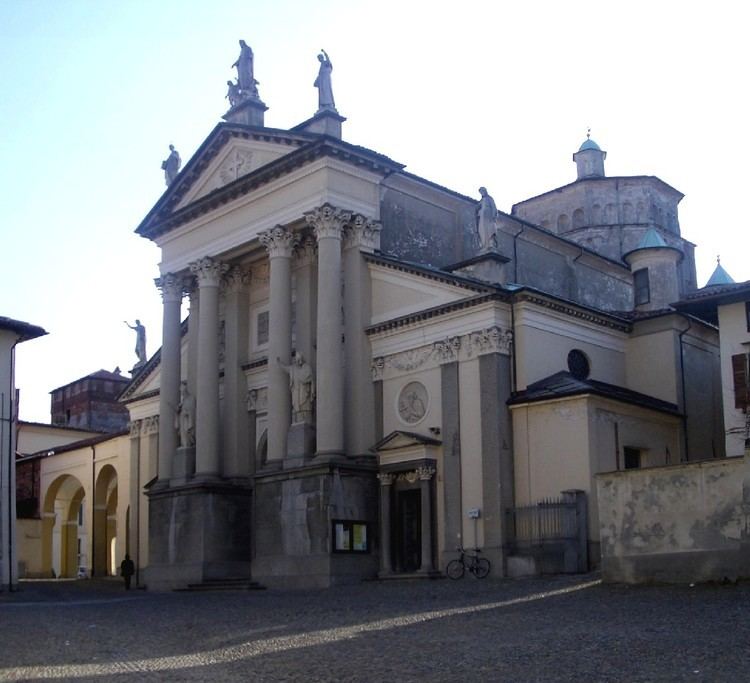Parishes 141 Area 1,850 km² Country Italy | Established 5th Century | |
 | ||
Population- Total- Catholics (as of 2006)203,560200,848 (98.7%) Cathedral Cattedrale di S. Maria Assunta Similar Diocesi Di Biella, Chiesa S Antonio Abate, Duomo Di Ivrea, Santuario Monte Stella, Santuario di NS di Oropa | ||
The Italian Catholic Diocese of Ivrea (Latin: Dioecesis Eporediensis) is in Piedmont. It is a suffragan of the Archdiocese of Turin.
Contents
History
Ivrea is on the Via Francigena, a pilgrim route that started as far away as Canterbury in England, and brought pilgrims through the St. Bernard passes in the Alps to Rome. During the Middle Ages, pilgrims could travel on to Bari and take ship for Jerusalem. The episcopal see of Ivrea is said to have been established by Eusebius of Vercelli about the middle of the fourth century. The first historically certain bishop is Eulogius (c. 451).
According to tradition, Ivrea is where Saint Patrick was consecrated bishop before evangelizing Ireland. Saint Malachy of Armagh passed through Ivrea in 1139 on his way to Rome. In 1847 the Bishop Ivrea sent the Archbishop of Dublin forty pounds for the famine-stricken people of Ireland in memory of an Irish pilgrim who had died in Ivrea in 1492.
On October 7, 2012, Msgr. Edoardo Aldo Cerrato, C.O., former Procurator General of the Confederation of Oratories of Saint Philip Neri, was installed as Bishop of the Diocese of Ivrea.
Cathedral of Santa Maria Assunta
The Cathedral of Santa Maria Assunta is located on the Via San Savino in Ivrea.
Architecture
The cathedral is built on the site of a first century Roman temple. Between the fourth and fifth century, a Christian church was constructed to the design of a Roman basilica. In the eleventh century, Bishop Warmondo, who was named bishop by Emperor Otto III, enlarged the structure in the Romanesque style. Warmondo also established a scriptorium. As the apse and other portions of Warmondo's work remains, the cathedral constitutes an important example of Romanesque architecture in the Canavese.
Reconstruction in the twelfth century rebuilt the upper portions of the bell towers, that may have collapsed during the 1117 Verona earthquake.
In 1516 Bishop Bonafacio Ferrero replaced the Romanesque façade with a Bramante-style portico, which in turn was changed to a Palladian style in 1854. Bishop Ottavio Pocchettini later commissioned architect Giuseppe Martinez to remodel the building in Late Baroque style.
Art
The carved walnut reredos depicting motifs of plants, human and animal figures, attributed to Baldino of Surso are now in the Civic Museum of Ancient Art in Turin. The crypt contains frescoes from the thirteenth to the fifteenth century, some damaged by time. On the foundation pillar of the southern bell tower, a holy warrior is depicted, possibly representing a member of the Theban Legion. There is also some early work by Giacomino of Ivrea and a painting attributed to the Maestro di Oropa.
In the sacristy is a 1521 depiction of the Adoration of the Child with the Blessed Warmondo and donor by Piedmont master Defendente Ferrari. A second Ferrari, the Adoration of the Child with St. Clare and the Poor Clares was re-located to the chapter room from the former convent of Santa Chiara in Ivrea, abolished in 1802.
Religious congregations
Notables
Bishops
Among the other bishops were: and Cardinal Richelmy (1886), who became Archbishop of Turin.
Hugo (1053), a son of King Arduinus;
...Alberto Gonzaga (1288);
...Parishes
There are 141 parishes, 140 within the Piedmontese Province of Turin and the other within the Province of Vercelli, also in Piedmont.
